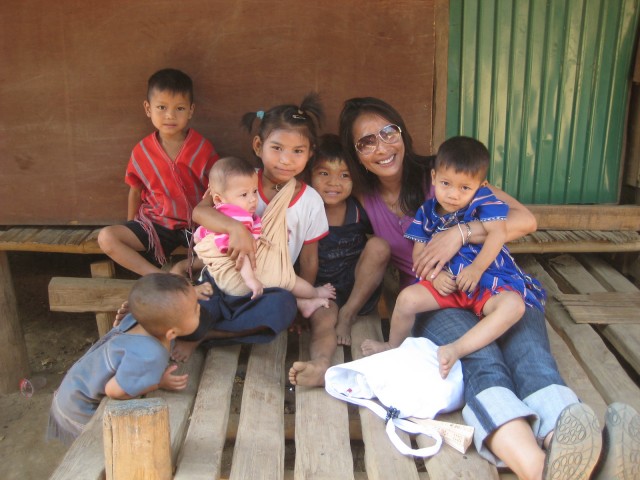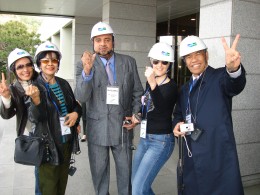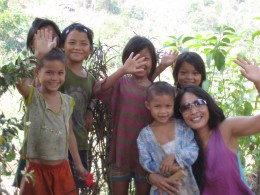[vc_row][vc_column width=”1/1″][vc_column_text]
Immigrant stories: Constance Castrence
By Jennifer Brookland
[/vc_column_text][/vc_column][/vc_row][vc_row][vc_column width=”2/3″][vc_column_text]

In the early 1950s, a sociologist and anthropologist named Ruth Useem coined the term “third-culture kid.” She was referring to children who go with their parents into another society—kids who grow up speaking one language at home and another everywhere else. Kids like Constance Castrence.
Constance was born to Filipino parents in Manila, went to primary school in Thailand, high school in Sydney and spent her young adult years in New York, Japan, Korea and Toronto.
“It’s funny, because I could meet TCKs [third-culture kids] from different generations, they could be 20 years older or younger than me, but we hit it off,” she says. “We can’t really explain it, but there’s that connection.”
The child of diplomats, Constance liked living in different cultures, though it was sometimes hard dealing with the pressure to fit in and move on.
“As an adult, I appreciate the fact that I did live in different cultures and I was different. But as a child you don’t understand that, and you’re always trying to be like them, whatever country that you’re in,” she says. “It’s hard enough to try to fit in and then, after maybe the third year, you’ve made friends and then you leave and then you start the whole process again, trying to fit.”

When it rains, she still thinks of the years she spent as a little girl in the Philippines—her siblings and cousins running around outside the family compound in the torrential rain, pretending to be speeding cars careening under the dripping leaves of the garden trees.
To keep the feeling of home close by as she moved around, Constance formed close relationships with her siblings, and cloaked herself in the Filipino culture her parents had grown up with and wanted their children to preserve.
Constance went to dance and singing classes, lessons she used to entertain her parents’ diplomatic friends and guests from home. They spoke Tagalog in the house as a way of maintaining a connection to the culture no matter the distance.
But living in various cities gave Constance a taste of the world, as her family was invited to experience traditional events and ceremonies in each country they lived in. Their home was filled with interesting objects from all over: Each vase had a past, each tapestry a story.
“Little do you know as an adult, that’s what kept us grounded,” Constance says, “just by traveling.”
When her mother was posted to the United States in 1986, Constance and her brother first flew to Los Angeles to stay with their cousins for a few months, before joining their mother in Washington, D.C.
In the United States, everything was big, everything was convenient and available. The glass doors on the drink cases at the 7-Eleven were just as sleek and novel as Constance had imagined them after watching U.S. TV shows.
“I loved it,” Constance remembers. “It really was this big U.S. of A.”
For the experience (and the nightlife), Constance moved into the shiny, glamorous world of New York City—the epitome of a cosmopolitan city—straight out of college. She took a low-paying job in a big department store, supported the causes du jour and partied at night.
During her stint in the Big Apple, Constance enjoyed volunteering and supporting issues she believed in, especially women’s issues; and when her money ran out, she moved back to D.C. to pursue a Master’s degree.

While a graduate student in 1991, Constance joined Creative as an intern. There were 30 or 40 employees at the company at that point. She and President Charito Kruvant would go to grocery stores to buy plastic plates and food to serve at USAID meetings.
“I really, really loved it. And I still do, that’s why I’m here.”
After working on and off for Creative, Constance took a leave of absence to volunteer in Thailand, where she worked with 12 to 18-year old girls whose status as extremely poor or orphans made them vulnerable to human trafficking.
As she became like a big sister to them—teaching them hula and salsa, writing out the words to Celine Dion songs and coaching them through art projects—the experience reignited her love of helping others. It led her back to Creative.
When it came time for her parents to return to the Philippines in 1993, Constance thought about going back with them. But their departure, back to a country she’d mostly had a long-distance relationship with, somehow freed her to make Washington her home.
“My heart is of course in the Philippines,” she says. “But this is where I feel the most comfortable. And maybe in the back of my mind, even though I still love traveling…D.C. gave me that feeling of a real home.”[/vc_column_text][/vc_column][vc_column width=”1/12″][/vc_column][vc_column width=”1/4″][vc_widget_sidebar sidebar_id=”sidebar-primary”][/vc_column][/vc_row]